Information Management & Strategic Decisions: Qualifi Level 7 Diploma
VerifiedAdded on 2023/06/18
|12
|3588
|383
Report
AI Summary
This report examines the role of information management systems (MIS) in strategic decision-making, focusing on Air Arabia Egypt as a case study. It covers the process of converting data into information, knowledge, and wisdom, emphasizing the importance of data validity and reliability. The report details the functions and impact of MIS on organizational efficiency and effectiveness, addressing legal compliance, data security, and employee access to information. It analyzes information formats, identifies patterns and trends affecting strategic decisions, and discusses electronic decision-making tools. Furthermore, the report explores data collection methods, internal and external information sources, and factors influencing operational decisions, concluding with recommendations for improvements in information management practices.

Management
Paraphrase This Document
Need a fresh take? Get an instant paraphrase of this document with our AI Paraphraser
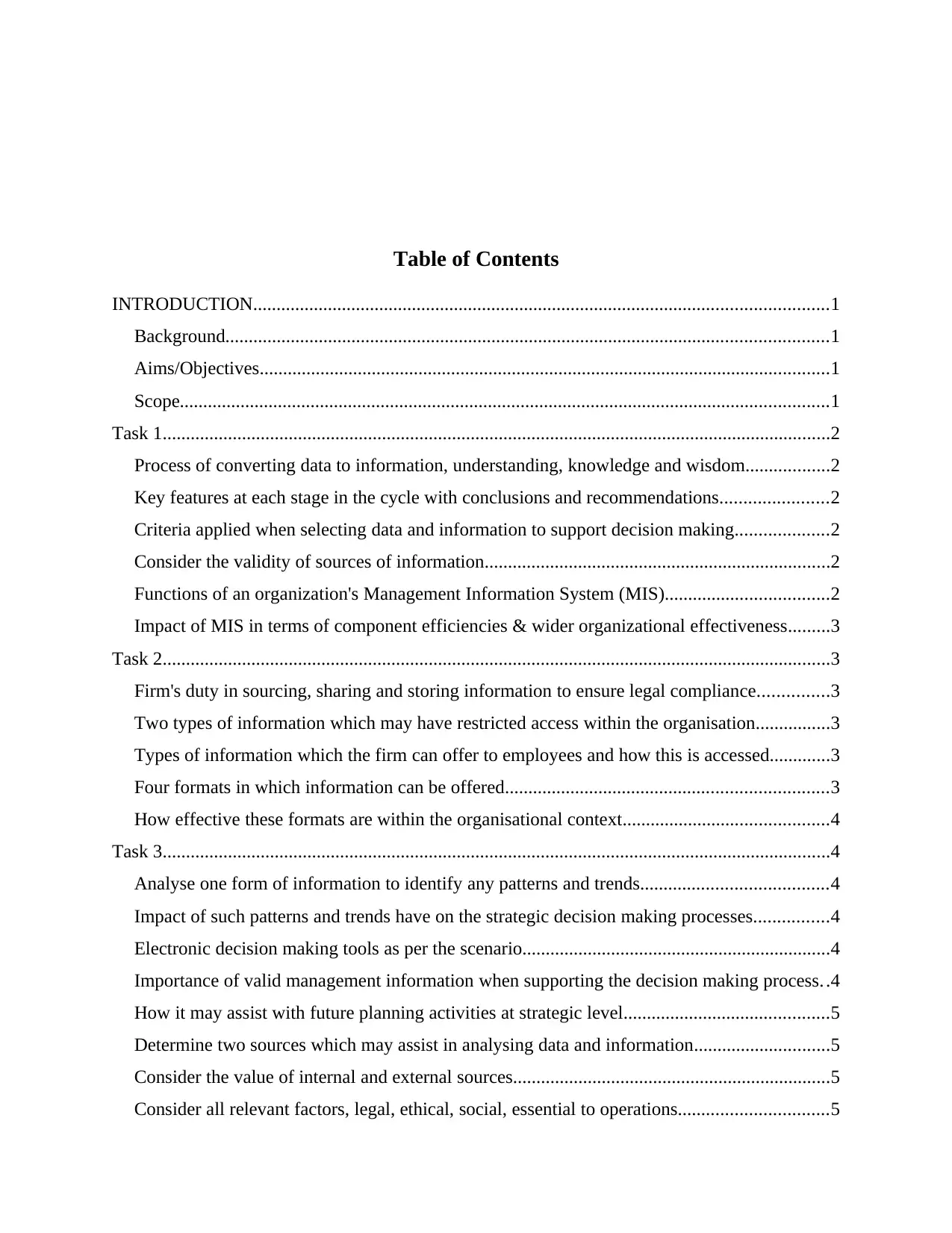
Table of Contents
INTRODUCTION...........................................................................................................................1
Background.................................................................................................................................1
Aims/Objectives..........................................................................................................................1
Scope...........................................................................................................................................1
Task 1...............................................................................................................................................2
Process of converting data to information, understanding, knowledge and wisdom..................2
Key features at each stage in the cycle with conclusions and recommendations.......................2
Criteria applied when selecting data and information to support decision making....................2
Consider the validity of sources of information..........................................................................2
Functions of an organization's Management Information System (MIS)...................................2
Impact of MIS in terms of component efficiencies & wider organizational effectiveness.........3
Task 2...............................................................................................................................................3
Firm's duty in sourcing, sharing and storing information to ensure legal compliance...............3
Two types of information which may have restricted access within the organisation................3
Types of information which the firm can offer to employees and how this is accessed.............3
Four formats in which information can be offered.....................................................................3
How effective these formats are within the organisational context............................................4
Task 3...............................................................................................................................................4
Analyse one form of information to identify any patterns and trends........................................4
Impact of such patterns and trends have on the strategic decision making processes................4
Electronic decision making tools as per the scenario..................................................................4
Importance of valid management information when supporting the decision making process. .4
How it may assist with future planning activities at strategic level............................................5
Determine two sources which may assist in analysing data and information.............................5
Consider the value of internal and external sources....................................................................5
Consider all relevant factors, legal, ethical, social, essential to operations................................5
INTRODUCTION...........................................................................................................................1
Background.................................................................................................................................1
Aims/Objectives..........................................................................................................................1
Scope...........................................................................................................................................1
Task 1...............................................................................................................................................2
Process of converting data to information, understanding, knowledge and wisdom..................2
Key features at each stage in the cycle with conclusions and recommendations.......................2
Criteria applied when selecting data and information to support decision making....................2
Consider the validity of sources of information..........................................................................2
Functions of an organization's Management Information System (MIS)...................................2
Impact of MIS in terms of component efficiencies & wider organizational effectiveness.........3
Task 2...............................................................................................................................................3
Firm's duty in sourcing, sharing and storing information to ensure legal compliance...............3
Two types of information which may have restricted access within the organisation................3
Types of information which the firm can offer to employees and how this is accessed.............3
Four formats in which information can be offered.....................................................................3
How effective these formats are within the organisational context............................................4
Task 3...............................................................................................................................................4
Analyse one form of information to identify any patterns and trends........................................4
Impact of such patterns and trends have on the strategic decision making processes................4
Electronic decision making tools as per the scenario..................................................................4
Importance of valid management information when supporting the decision making process. .4
How it may assist with future planning activities at strategic level............................................5
Determine two sources which may assist in analysing data and information.............................5
Consider the value of internal and external sources....................................................................5
Consider all relevant factors, legal, ethical, social, essential to operations................................5
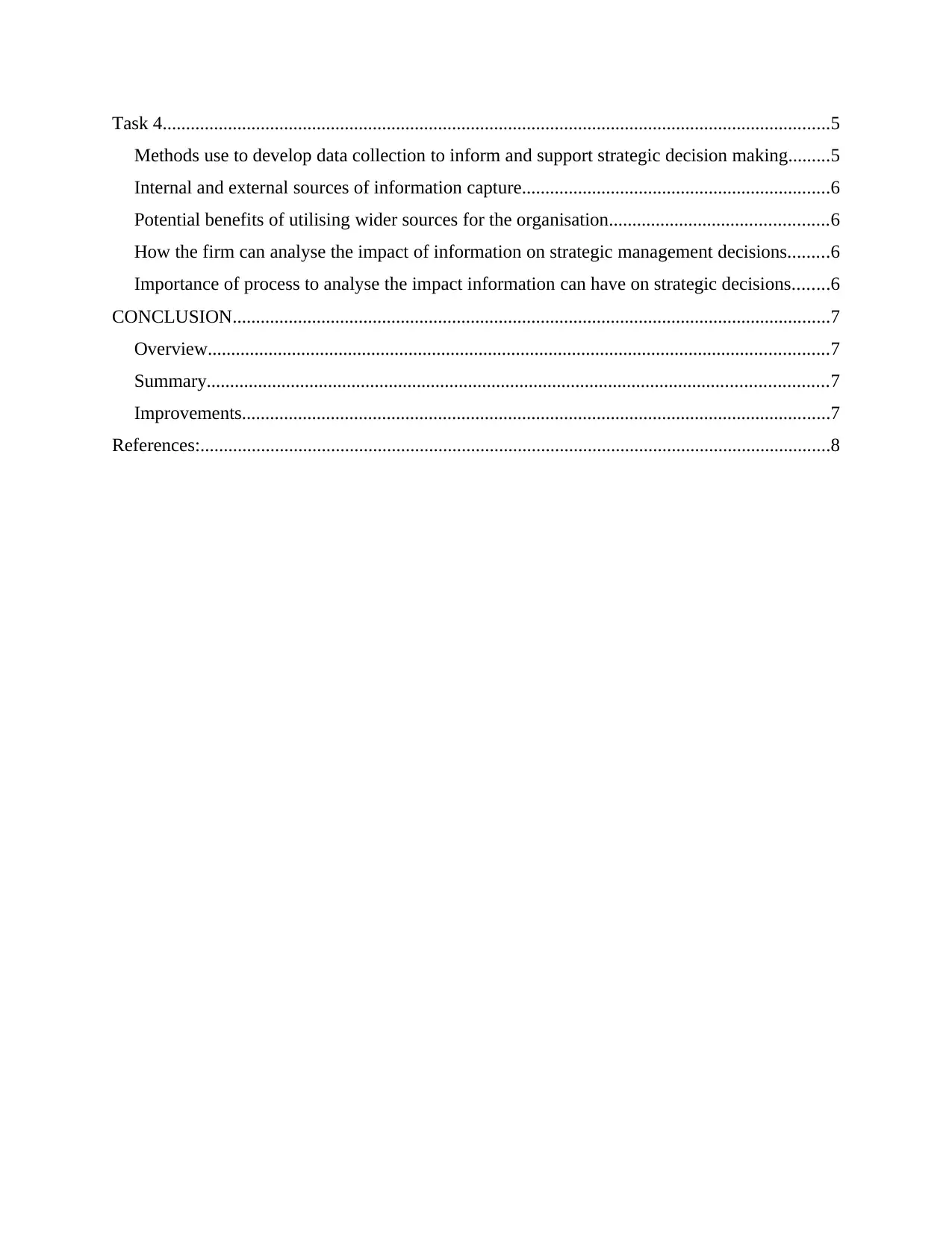
Task 4...............................................................................................................................................5
Methods use to develop data collection to inform and support strategic decision making.........5
Internal and external sources of information capture..................................................................6
Potential benefits of utilising wider sources for the organisation...............................................6
How the firm can analyse the impact of information on strategic management decisions.........6
Importance of process to analyse the impact information can have on strategic decisions........6
CONCLUSION................................................................................................................................7
Overview.....................................................................................................................................7
Summary.....................................................................................................................................7
Improvements..............................................................................................................................7
References:.......................................................................................................................................8
Methods use to develop data collection to inform and support strategic decision making.........5
Internal and external sources of information capture..................................................................6
Potential benefits of utilising wider sources for the organisation...............................................6
How the firm can analyse the impact of information on strategic management decisions.........6
Importance of process to analyse the impact information can have on strategic decisions........6
CONCLUSION................................................................................................................................7
Overview.....................................................................................................................................7
Summary.....................................................................................................................................7
Improvements..............................................................................................................................7
References:.......................................................................................................................................8
⊘ This is a preview!⊘
Do you want full access?
Subscribe today to unlock all pages.

Trusted by 1+ million students worldwide
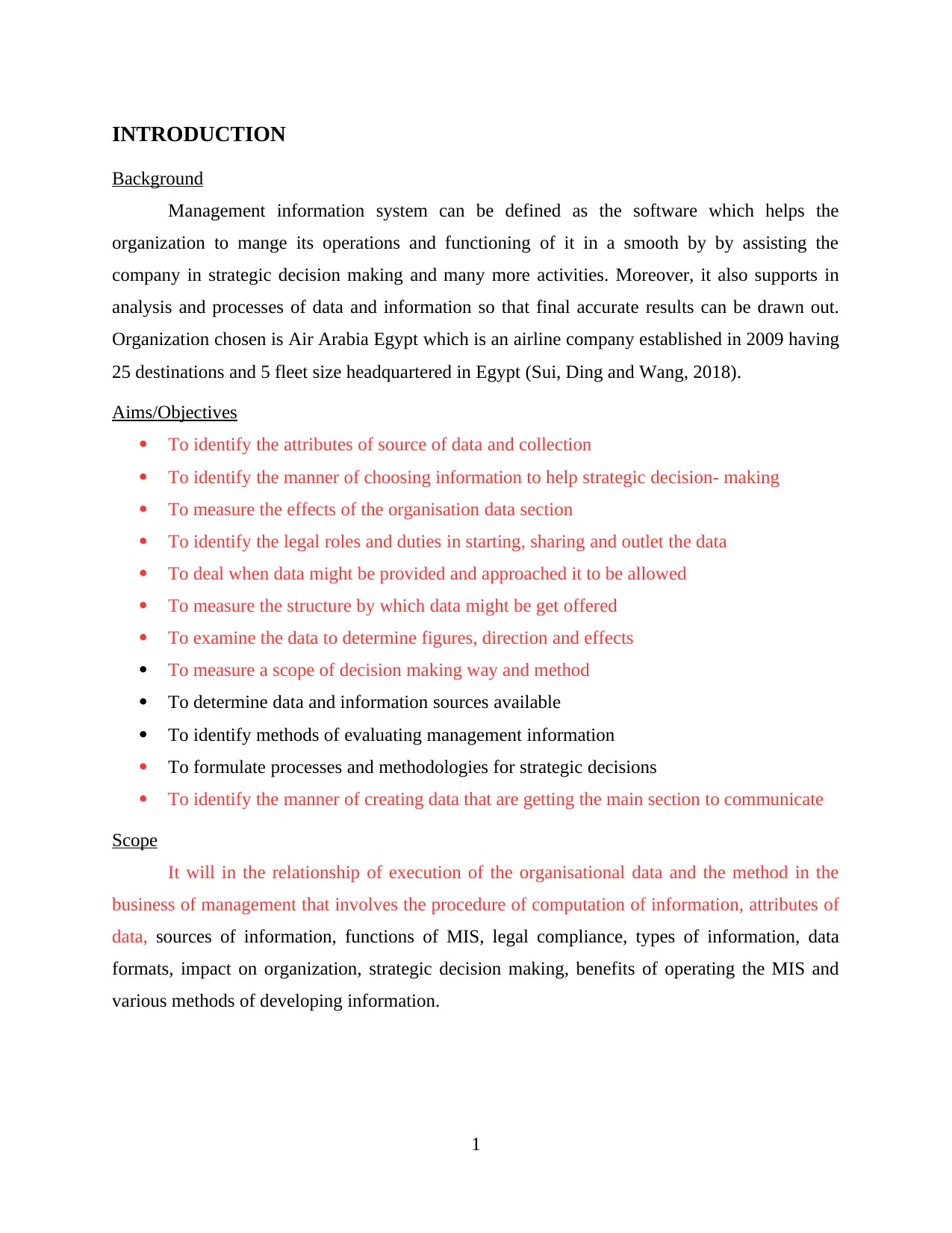
INTRODUCTION
Background
Management information system can be defined as the software which helps the
organization to mange its operations and functioning of it in a smooth by by assisting the
company in strategic decision making and many more activities. Moreover, it also supports in
analysis and processes of data and information so that final accurate results can be drawn out.
Organization chosen is Air Arabia Egypt which is an airline company established in 2009 having
25 destinations and 5 fleet size headquartered in Egypt (Sui, Ding and Wang, 2018).
Aims/Objectives
To identify the attributes of source of data and collection
To identify the manner of choosing information to help strategic decision- making
To measure the effects of the organisation data section
To identify the legal roles and duties in starting, sharing and outlet the data
To deal when data might be provided and approached it to be allowed
To measure the structure by which data might be get offered
To examine the data to determine figures, direction and effects
To measure a scope of decision making way and method
To determine data and information sources available
To identify methods of evaluating management information
To formulate processes and methodologies for strategic decisions
To identify the manner of creating data that are getting the main section to communicate
Scope
It will in the relationship of execution of the organisational data and the method in the
business of management that involves the procedure of computation of information, attributes of
data, sources of information, functions of MIS, legal compliance, types of information, data
formats, impact on organization, strategic decision making, benefits of operating the MIS and
various methods of developing information.
1
Background
Management information system can be defined as the software which helps the
organization to mange its operations and functioning of it in a smooth by by assisting the
company in strategic decision making and many more activities. Moreover, it also supports in
analysis and processes of data and information so that final accurate results can be drawn out.
Organization chosen is Air Arabia Egypt which is an airline company established in 2009 having
25 destinations and 5 fleet size headquartered in Egypt (Sui, Ding and Wang, 2018).
Aims/Objectives
To identify the attributes of source of data and collection
To identify the manner of choosing information to help strategic decision- making
To measure the effects of the organisation data section
To identify the legal roles and duties in starting, sharing and outlet the data
To deal when data might be provided and approached it to be allowed
To measure the structure by which data might be get offered
To examine the data to determine figures, direction and effects
To measure a scope of decision making way and method
To determine data and information sources available
To identify methods of evaluating management information
To formulate processes and methodologies for strategic decisions
To identify the manner of creating data that are getting the main section to communicate
Scope
It will in the relationship of execution of the organisational data and the method in the
business of management that involves the procedure of computation of information, attributes of
data, sources of information, functions of MIS, legal compliance, types of information, data
formats, impact on organization, strategic decision making, benefits of operating the MIS and
various methods of developing information.
1
Paraphrase This Document
Need a fresh take? Get an instant paraphrase of this document with our AI Paraphraser
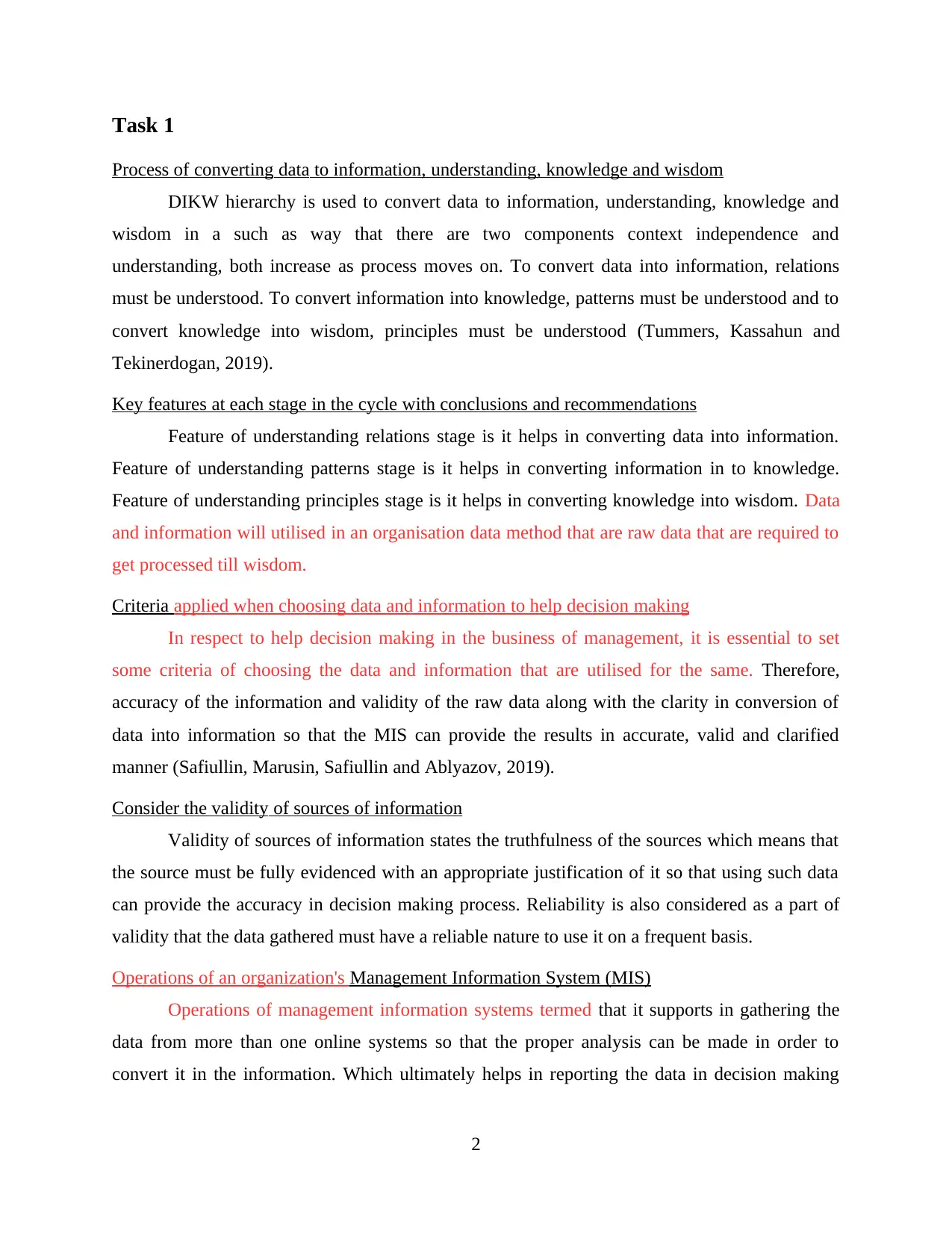
Task 1
Process of converting data to information, understanding, knowledge and wisdom
DIKW hierarchy is used to convert data to information, understanding, knowledge and
wisdom in a such as way that there are two components context independence and
understanding, both increase as process moves on. To convert data into information, relations
must be understood. To convert information into knowledge, patterns must be understood and to
convert knowledge into wisdom, principles must be understood (Tummers, Kassahun and
Tekinerdogan, 2019).
Key features at each stage in the cycle with conclusions and recommendations
Feature of understanding relations stage is it helps in converting data into information.
Feature of understanding patterns stage is it helps in converting information in to knowledge.
Feature of understanding principles stage is it helps in converting knowledge into wisdom. Data
and information will utilised in an organisation data method that are raw data that are required to
get processed till wisdom.
Criteria applied when choosing data and information to help decision making
In respect to help decision making in the business of management, it is essential to set
some criteria of choosing the data and information that are utilised for the same. Therefore,
accuracy of the information and validity of the raw data along with the clarity in conversion of
data into information so that the MIS can provide the results in accurate, valid and clarified
manner (Safiullin, Marusin, Safiullin and Ablyazov, 2019).
Consider the validity of sources of information
Validity of sources of information states the truthfulness of the sources which means that
the source must be fully evidenced with an appropriate justification of it so that using such data
can provide the accuracy in decision making process. Reliability is also considered as a part of
validity that the data gathered must have a reliable nature to use it on a frequent basis.
Operations of an organization's Management Information System (MIS)
Operations of management information systems termed that it supports in gathering the
data from more than one online systems so that the proper analysis can be made in order to
convert it in the information. Which ultimately helps in reporting the data in decision making
2
Process of converting data to information, understanding, knowledge and wisdom
DIKW hierarchy is used to convert data to information, understanding, knowledge and
wisdom in a such as way that there are two components context independence and
understanding, both increase as process moves on. To convert data into information, relations
must be understood. To convert information into knowledge, patterns must be understood and to
convert knowledge into wisdom, principles must be understood (Tummers, Kassahun and
Tekinerdogan, 2019).
Key features at each stage in the cycle with conclusions and recommendations
Feature of understanding relations stage is it helps in converting data into information.
Feature of understanding patterns stage is it helps in converting information in to knowledge.
Feature of understanding principles stage is it helps in converting knowledge into wisdom. Data
and information will utilised in an organisation data method that are raw data that are required to
get processed till wisdom.
Criteria applied when choosing data and information to help decision making
In respect to help decision making in the business of management, it is essential to set
some criteria of choosing the data and information that are utilised for the same. Therefore,
accuracy of the information and validity of the raw data along with the clarity in conversion of
data into information so that the MIS can provide the results in accurate, valid and clarified
manner (Safiullin, Marusin, Safiullin and Ablyazov, 2019).
Consider the validity of sources of information
Validity of sources of information states the truthfulness of the sources which means that
the source must be fully evidenced with an appropriate justification of it so that using such data
can provide the accuracy in decision making process. Reliability is also considered as a part of
validity that the data gathered must have a reliable nature to use it on a frequent basis.
Operations of an organization's Management Information System (MIS)
Operations of management information systems termed that it supports in gathering the
data from more than one online systems so that the proper analysis can be made in order to
convert it in the information. Which ultimately helps in reporting the data in decision making
2
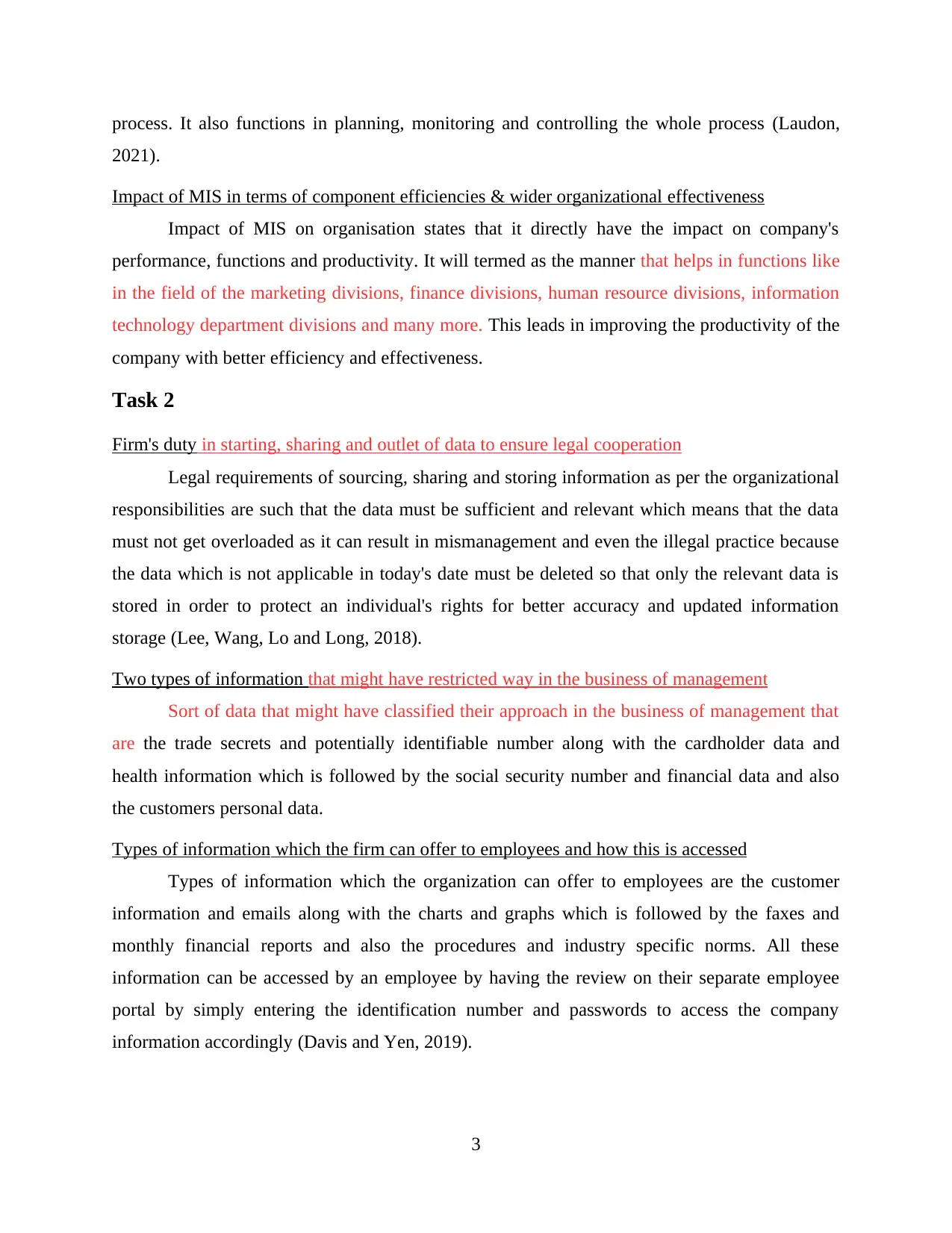
process. It also functions in planning, monitoring and controlling the whole process (Laudon,
2021).
Impact of MIS in terms of component efficiencies & wider organizational effectiveness
Impact of MIS on organisation states that it directly have the impact on company's
performance, functions and productivity. It will termed as the manner that helps in functions like
in the field of the marketing divisions, finance divisions, human resource divisions, information
technology department divisions and many more. This leads in improving the productivity of the
company with better efficiency and effectiveness.
Task 2
Firm's duty in starting, sharing and outlet of data to ensure legal cooperation
Legal requirements of sourcing, sharing and storing information as per the organizational
responsibilities are such that the data must be sufficient and relevant which means that the data
must not get overloaded as it can result in mismanagement and even the illegal practice because
the data which is not applicable in today's date must be deleted so that only the relevant data is
stored in order to protect an individual's rights for better accuracy and updated information
storage (Lee, Wang, Lo and Long, 2018).
Two types of information that might have restricted way in the business of management
Sort of data that might have classified their approach in the business of management that
are the trade secrets and potentially identifiable number along with the cardholder data and
health information which is followed by the social security number and financial data and also
the customers personal data.
Types of information which the firm can offer to employees and how this is accessed
Types of information which the organization can offer to employees are the customer
information and emails along with the charts and graphs which is followed by the faxes and
monthly financial reports and also the procedures and industry specific norms. All these
information can be accessed by an employee by having the review on their separate employee
portal by simply entering the identification number and passwords to access the company
information accordingly (Davis and Yen, 2019).
3
2021).
Impact of MIS in terms of component efficiencies & wider organizational effectiveness
Impact of MIS on organisation states that it directly have the impact on company's
performance, functions and productivity. It will termed as the manner that helps in functions like
in the field of the marketing divisions, finance divisions, human resource divisions, information
technology department divisions and many more. This leads in improving the productivity of the
company with better efficiency and effectiveness.
Task 2
Firm's duty in starting, sharing and outlet of data to ensure legal cooperation
Legal requirements of sourcing, sharing and storing information as per the organizational
responsibilities are such that the data must be sufficient and relevant which means that the data
must not get overloaded as it can result in mismanagement and even the illegal practice because
the data which is not applicable in today's date must be deleted so that only the relevant data is
stored in order to protect an individual's rights for better accuracy and updated information
storage (Lee, Wang, Lo and Long, 2018).
Two types of information that might have restricted way in the business of management
Sort of data that might have classified their approach in the business of management that
are the trade secrets and potentially identifiable number along with the cardholder data and
health information which is followed by the social security number and financial data and also
the customers personal data.
Types of information which the firm can offer to employees and how this is accessed
Types of information which the organization can offer to employees are the customer
information and emails along with the charts and graphs which is followed by the faxes and
monthly financial reports and also the procedures and industry specific norms. All these
information can be accessed by an employee by having the review on their separate employee
portal by simply entering the identification number and passwords to access the company
information accordingly (Davis and Yen, 2019).
3
⊘ This is a preview!⊘
Do you want full access?
Subscribe today to unlock all pages.

Trusted by 1+ million students worldwide
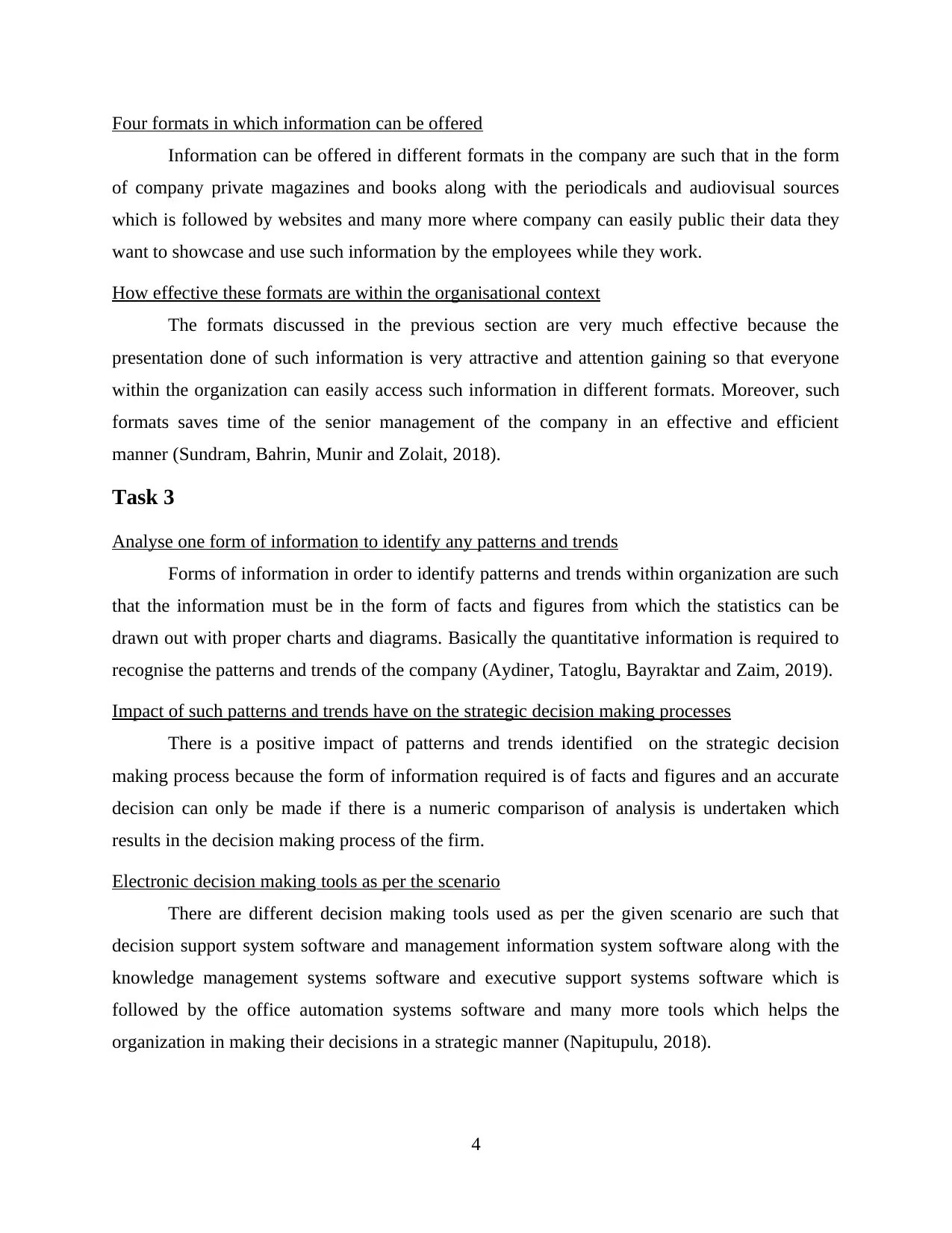
Four formats in which information can be offered
Information can be offered in different formats in the company are such that in the form
of company private magazines and books along with the periodicals and audiovisual sources
which is followed by websites and many more where company can easily public their data they
want to showcase and use such information by the employees while they work.
How effective these formats are within the organisational context
The formats discussed in the previous section are very much effective because the
presentation done of such information is very attractive and attention gaining so that everyone
within the organization can easily access such information in different formats. Moreover, such
formats saves time of the senior management of the company in an effective and efficient
manner (Sundram, Bahrin, Munir and Zolait, 2018).
Task 3
Analyse one form of information to identify any patterns and trends
Forms of information in order to identify patterns and trends within organization are such
that the information must be in the form of facts and figures from which the statistics can be
drawn out with proper charts and diagrams. Basically the quantitative information is required to
recognise the patterns and trends of the company (Aydiner, Tatoglu, Bayraktar and Zaim, 2019).
Impact of such patterns and trends have on the strategic decision making processes
There is a positive impact of patterns and trends identified on the strategic decision
making process because the form of information required is of facts and figures and an accurate
decision can only be made if there is a numeric comparison of analysis is undertaken which
results in the decision making process of the firm.
Electronic decision making tools as per the scenario
There are different decision making tools used as per the given scenario are such that
decision support system software and management information system software along with the
knowledge management systems software and executive support systems software which is
followed by the office automation systems software and many more tools which helps the
organization in making their decisions in a strategic manner (Napitupulu, 2018).
4
Information can be offered in different formats in the company are such that in the form
of company private magazines and books along with the periodicals and audiovisual sources
which is followed by websites and many more where company can easily public their data they
want to showcase and use such information by the employees while they work.
How effective these formats are within the organisational context
The formats discussed in the previous section are very much effective because the
presentation done of such information is very attractive and attention gaining so that everyone
within the organization can easily access such information in different formats. Moreover, such
formats saves time of the senior management of the company in an effective and efficient
manner (Sundram, Bahrin, Munir and Zolait, 2018).
Task 3
Analyse one form of information to identify any patterns and trends
Forms of information in order to identify patterns and trends within organization are such
that the information must be in the form of facts and figures from which the statistics can be
drawn out with proper charts and diagrams. Basically the quantitative information is required to
recognise the patterns and trends of the company (Aydiner, Tatoglu, Bayraktar and Zaim, 2019).
Impact of such patterns and trends have on the strategic decision making processes
There is a positive impact of patterns and trends identified on the strategic decision
making process because the form of information required is of facts and figures and an accurate
decision can only be made if there is a numeric comparison of analysis is undertaken which
results in the decision making process of the firm.
Electronic decision making tools as per the scenario
There are different decision making tools used as per the given scenario are such that
decision support system software and management information system software along with the
knowledge management systems software and executive support systems software which is
followed by the office automation systems software and many more tools which helps the
organization in making their decisions in a strategic manner (Napitupulu, 2018).
4
Paraphrase This Document
Need a fresh take? Get an instant paraphrase of this document with our AI Paraphraser
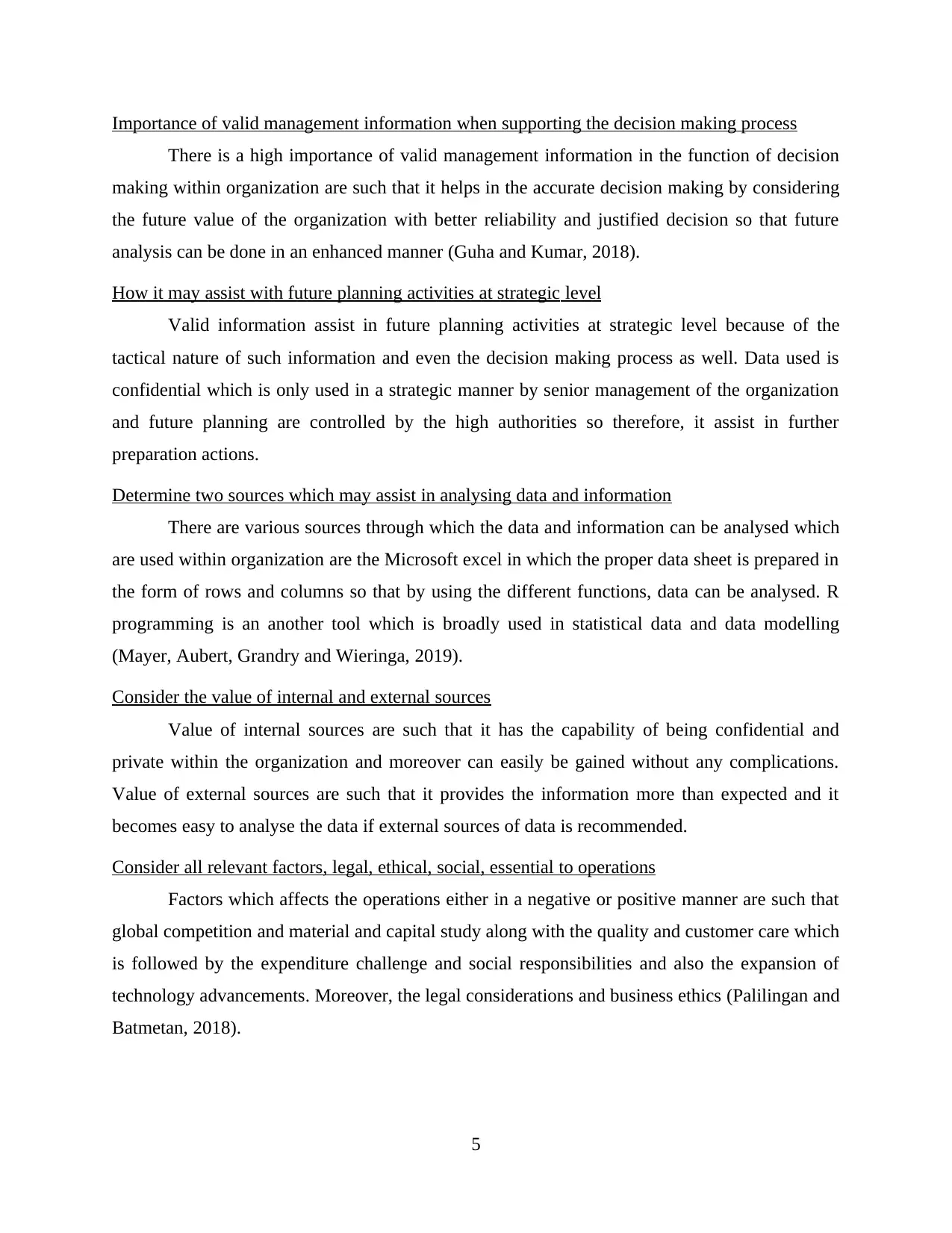
Importance of valid management information when supporting the decision making process
There is a high importance of valid management information in the function of decision
making within organization are such that it helps in the accurate decision making by considering
the future value of the organization with better reliability and justified decision so that future
analysis can be done in an enhanced manner (Guha and Kumar, 2018).
How it may assist with future planning activities at strategic level
Valid information assist in future planning activities at strategic level because of the
tactical nature of such information and even the decision making process as well. Data used is
confidential which is only used in a strategic manner by senior management of the organization
and future planning are controlled by the high authorities so therefore, it assist in further
preparation actions.
Determine two sources which may assist in analysing data and information
There are various sources through which the data and information can be analysed which
are used within organization are the Microsoft excel in which the proper data sheet is prepared in
the form of rows and columns so that by using the different functions, data can be analysed. R
programming is an another tool which is broadly used in statistical data and data modelling
(Mayer, Aubert, Grandry and Wieringa, 2019).
Consider the value of internal and external sources
Value of internal sources are such that it has the capability of being confidential and
private within the organization and moreover can easily be gained without any complications.
Value of external sources are such that it provides the information more than expected and it
becomes easy to analyse the data if external sources of data is recommended.
Consider all relevant factors, legal, ethical, social, essential to operations
Factors which affects the operations either in a negative or positive manner are such that
global competition and material and capital study along with the quality and customer care which
is followed by the expenditure challenge and social responsibilities and also the expansion of
technology advancements. Moreover, the legal considerations and business ethics (Palilingan and
Batmetan, 2018).
5
There is a high importance of valid management information in the function of decision
making within organization are such that it helps in the accurate decision making by considering
the future value of the organization with better reliability and justified decision so that future
analysis can be done in an enhanced manner (Guha and Kumar, 2018).
How it may assist with future planning activities at strategic level
Valid information assist in future planning activities at strategic level because of the
tactical nature of such information and even the decision making process as well. Data used is
confidential which is only used in a strategic manner by senior management of the organization
and future planning are controlled by the high authorities so therefore, it assist in further
preparation actions.
Determine two sources which may assist in analysing data and information
There are various sources through which the data and information can be analysed which
are used within organization are the Microsoft excel in which the proper data sheet is prepared in
the form of rows and columns so that by using the different functions, data can be analysed. R
programming is an another tool which is broadly used in statistical data and data modelling
(Mayer, Aubert, Grandry and Wieringa, 2019).
Consider the value of internal and external sources
Value of internal sources are such that it has the capability of being confidential and
private within the organization and moreover can easily be gained without any complications.
Value of external sources are such that it provides the information more than expected and it
becomes easy to analyse the data if external sources of data is recommended.
Consider all relevant factors, legal, ethical, social, essential to operations
Factors which affects the operations either in a negative or positive manner are such that
global competition and material and capital study along with the quality and customer care which
is followed by the expenditure challenge and social responsibilities and also the expansion of
technology advancements. Moreover, the legal considerations and business ethics (Palilingan and
Batmetan, 2018).
5
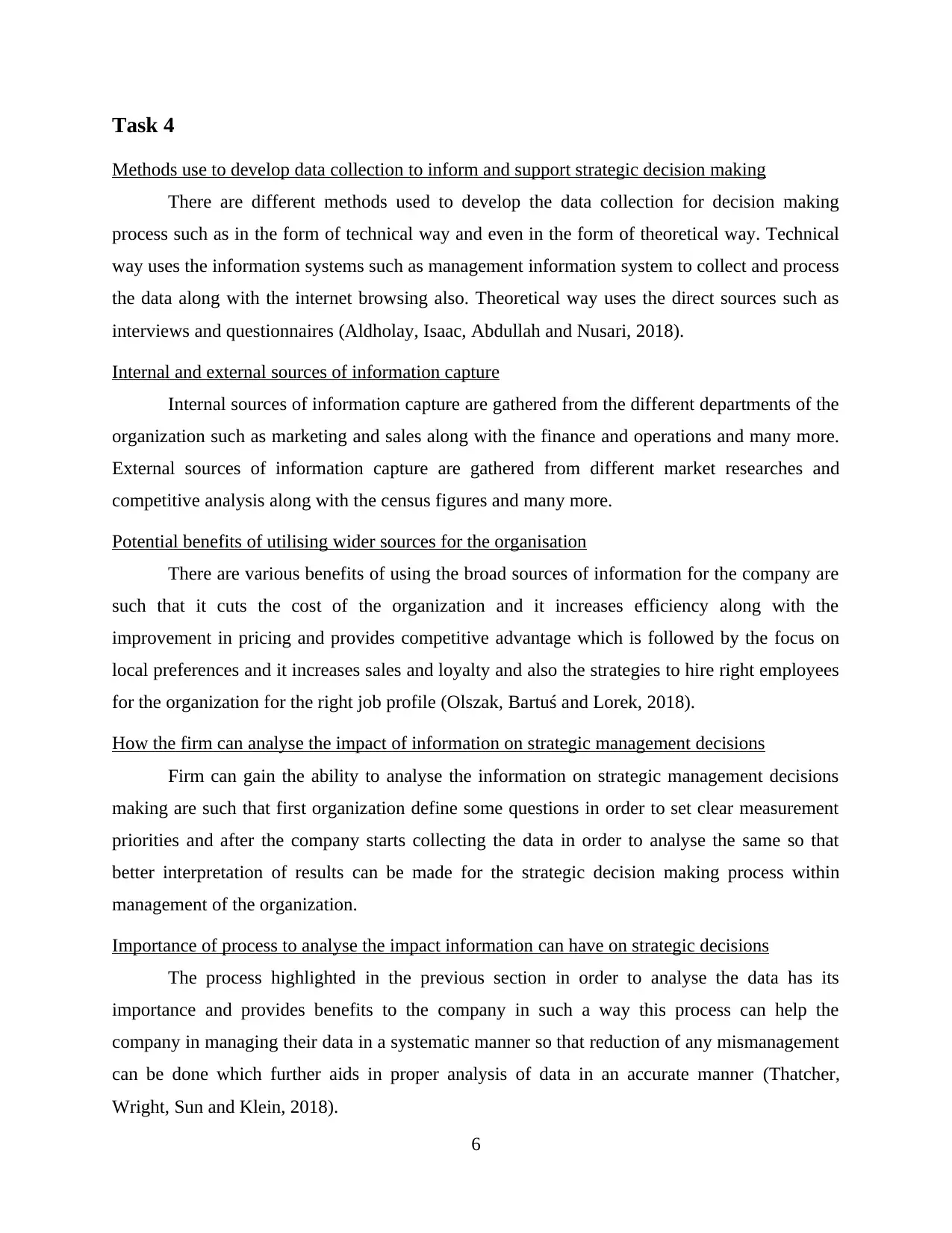
Task 4
Methods use to develop data collection to inform and support strategic decision making
There are different methods used to develop the data collection for decision making
process such as in the form of technical way and even in the form of theoretical way. Technical
way uses the information systems such as management information system to collect and process
the data along with the internet browsing also. Theoretical way uses the direct sources such as
interviews and questionnaires (Aldholay, Isaac, Abdullah and Nusari, 2018).
Internal and external sources of information capture
Internal sources of information capture are gathered from the different departments of the
organization such as marketing and sales along with the finance and operations and many more.
External sources of information capture are gathered from different market researches and
competitive analysis along with the census figures and many more.
Potential benefits of utilising wider sources for the organisation
There are various benefits of using the broad sources of information for the company are
such that it cuts the cost of the organization and it increases efficiency along with the
improvement in pricing and provides competitive advantage which is followed by the focus on
local preferences and it increases sales and loyalty and also the strategies to hire right employees
for the organization for the right job profile (Olszak, Bartuś and Lorek, 2018).
How the firm can analyse the impact of information on strategic management decisions
Firm can gain the ability to analyse the information on strategic management decisions
making are such that first organization define some questions in order to set clear measurement
priorities and after the company starts collecting the data in order to analyse the same so that
better interpretation of results can be made for the strategic decision making process within
management of the organization.
Importance of process to analyse the impact information can have on strategic decisions
The process highlighted in the previous section in order to analyse the data has its
importance and provides benefits to the company in such a way this process can help the
company in managing their data in a systematic manner so that reduction of any mismanagement
can be done which further aids in proper analysis of data in an accurate manner (Thatcher,
Wright, Sun and Klein, 2018).
6
Methods use to develop data collection to inform and support strategic decision making
There are different methods used to develop the data collection for decision making
process such as in the form of technical way and even in the form of theoretical way. Technical
way uses the information systems such as management information system to collect and process
the data along with the internet browsing also. Theoretical way uses the direct sources such as
interviews and questionnaires (Aldholay, Isaac, Abdullah and Nusari, 2018).
Internal and external sources of information capture
Internal sources of information capture are gathered from the different departments of the
organization such as marketing and sales along with the finance and operations and many more.
External sources of information capture are gathered from different market researches and
competitive analysis along with the census figures and many more.
Potential benefits of utilising wider sources for the organisation
There are various benefits of using the broad sources of information for the company are
such that it cuts the cost of the organization and it increases efficiency along with the
improvement in pricing and provides competitive advantage which is followed by the focus on
local preferences and it increases sales and loyalty and also the strategies to hire right employees
for the organization for the right job profile (Olszak, Bartuś and Lorek, 2018).
How the firm can analyse the impact of information on strategic management decisions
Firm can gain the ability to analyse the information on strategic management decisions
making are such that first organization define some questions in order to set clear measurement
priorities and after the company starts collecting the data in order to analyse the same so that
better interpretation of results can be made for the strategic decision making process within
management of the organization.
Importance of process to analyse the impact information can have on strategic decisions
The process highlighted in the previous section in order to analyse the data has its
importance and provides benefits to the company in such a way this process can help the
company in managing their data in a systematic manner so that reduction of any mismanagement
can be done which further aids in proper analysis of data in an accurate manner (Thatcher,
Wright, Sun and Klein, 2018).
6
⊘ This is a preview!⊘
Do you want full access?
Subscribe today to unlock all pages.

Trusted by 1+ million students worldwide
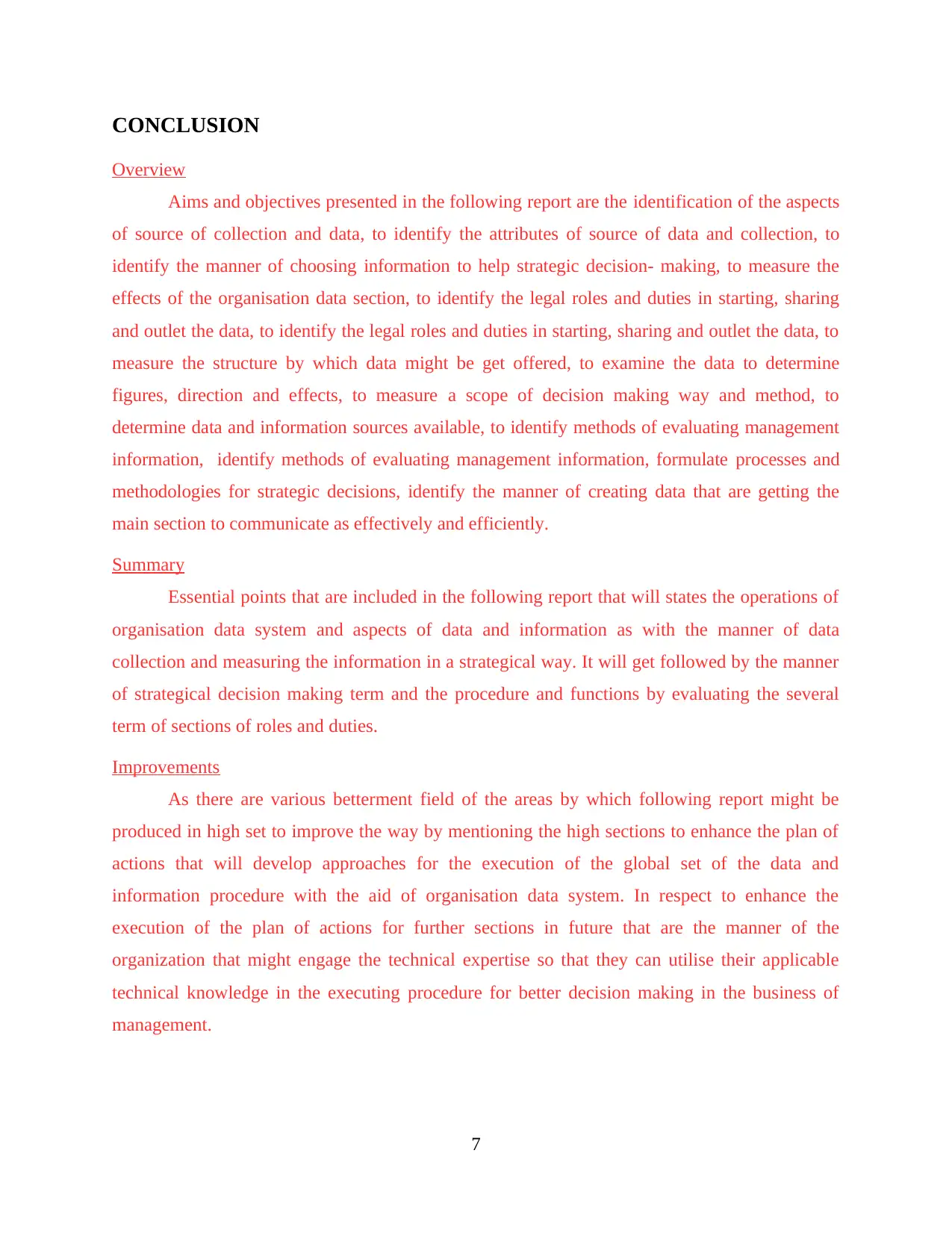
CONCLUSION
Overview
Aims and objectives presented in the following report are the identification of the aspects
of source of collection and data, to identify the attributes of source of data and collection, to
identify the manner of choosing information to help strategic decision- making, to measure the
effects of the organisation data section, to identify the legal roles and duties in starting, sharing
and outlet the data, to identify the legal roles and duties in starting, sharing and outlet the data, to
measure the structure by which data might be get offered, to examine the data to determine
figures, direction and effects, to measure a scope of decision making way and method, to
determine data and information sources available, to identify methods of evaluating management
information, identify methods of evaluating management information, formulate processes and
methodologies for strategic decisions, identify the manner of creating data that are getting the
main section to communicate as effectively and efficiently.
Summary
Essential points that are included in the following report that will states the operations of
organisation data system and aspects of data and information as with the manner of data
collection and measuring the information in a strategical way. It will get followed by the manner
of strategical decision making term and the procedure and functions by evaluating the several
term of sections of roles and duties.
Improvements
As there are various betterment field of the areas by which following report might be
produced in high set to improve the way by mentioning the high sections to enhance the plan of
actions that will develop approaches for the execution of the global set of the data and
information procedure with the aid of organisation data system. In respect to enhance the
execution of the plan of actions for further sections in future that are the manner of the
organization that might engage the technical expertise so that they can utilise their applicable
technical knowledge in the executing procedure for better decision making in the business of
management.
7
Overview
Aims and objectives presented in the following report are the identification of the aspects
of source of collection and data, to identify the attributes of source of data and collection, to
identify the manner of choosing information to help strategic decision- making, to measure the
effects of the organisation data section, to identify the legal roles and duties in starting, sharing
and outlet the data, to identify the legal roles and duties in starting, sharing and outlet the data, to
measure the structure by which data might be get offered, to examine the data to determine
figures, direction and effects, to measure a scope of decision making way and method, to
determine data and information sources available, to identify methods of evaluating management
information, identify methods of evaluating management information, formulate processes and
methodologies for strategic decisions, identify the manner of creating data that are getting the
main section to communicate as effectively and efficiently.
Summary
Essential points that are included in the following report that will states the operations of
organisation data system and aspects of data and information as with the manner of data
collection and measuring the information in a strategical way. It will get followed by the manner
of strategical decision making term and the procedure and functions by evaluating the several
term of sections of roles and duties.
Improvements
As there are various betterment field of the areas by which following report might be
produced in high set to improve the way by mentioning the high sections to enhance the plan of
actions that will develop approaches for the execution of the global set of the data and
information procedure with the aid of organisation data system. In respect to enhance the
execution of the plan of actions for further sections in future that are the manner of the
organization that might engage the technical expertise so that they can utilise their applicable
technical knowledge in the executing procedure for better decision making in the business of
management.
7
Paraphrase This Document
Need a fresh take? Get an instant paraphrase of this document with our AI Paraphraser
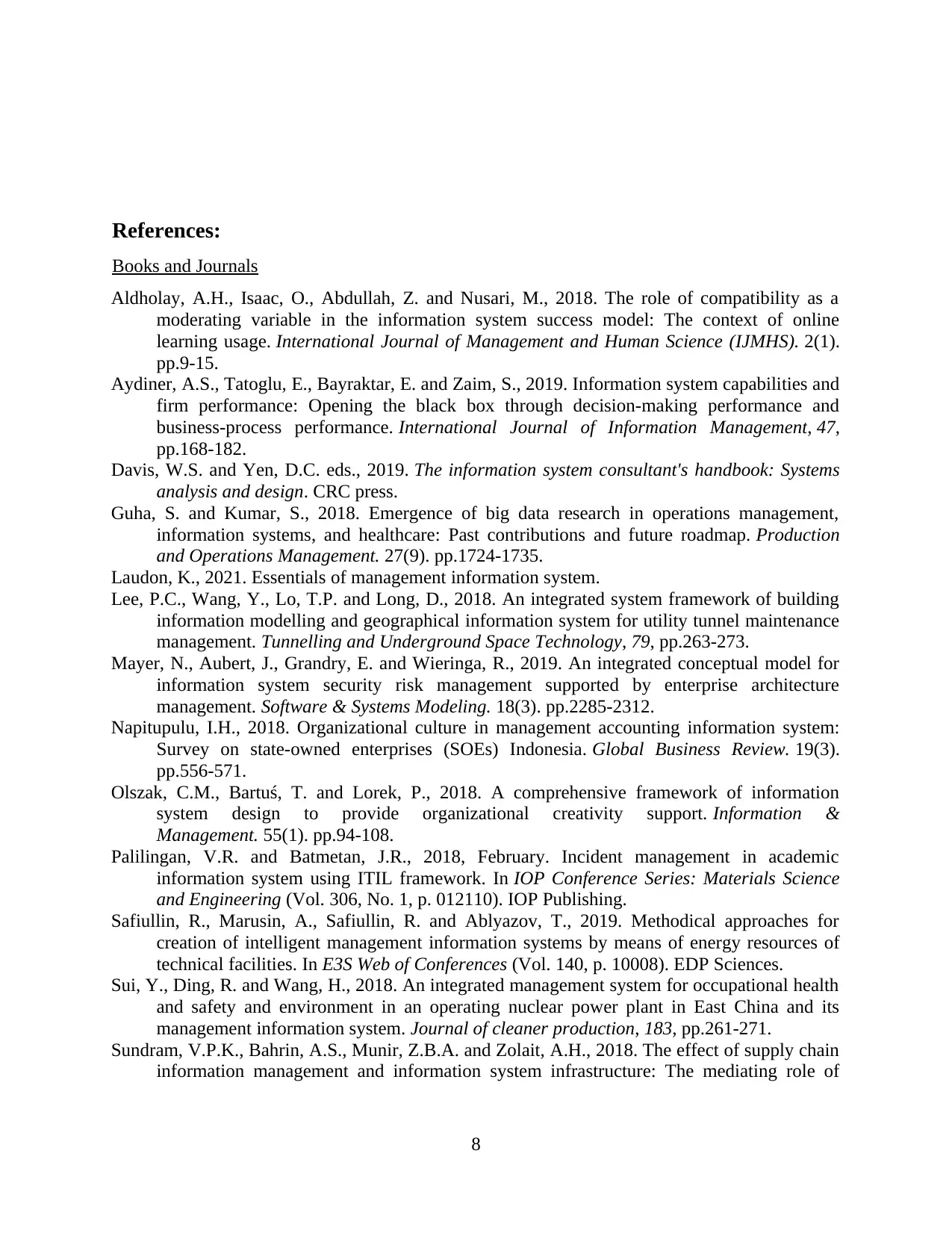
References:
Books and Journals
Aldholay, A.H., Isaac, O., Abdullah, Z. and Nusari, M., 2018. The role of compatibility as a
moderating variable in the information system success model: The context of online
learning usage. International Journal of Management and Human Science (IJMHS). 2(1).
pp.9-15.
Aydiner, A.S., Tatoglu, E., Bayraktar, E. and Zaim, S., 2019. Information system capabilities and
firm performance: Opening the black box through decision-making performance and
business-process performance. International Journal of Information Management, 47,
pp.168-182.
Davis, W.S. and Yen, D.C. eds., 2019. The information system consultant's handbook: Systems
analysis and design. CRC press.
Guha, S. and Kumar, S., 2018. Emergence of big data research in operations management,
information systems, and healthcare: Past contributions and future roadmap. Production
and Operations Management. 27(9). pp.1724-1735.
Laudon, K., 2021. Essentials of management information system.
Lee, P.C., Wang, Y., Lo, T.P. and Long, D., 2018. An integrated system framework of building
information modelling and geographical information system for utility tunnel maintenance
management. Tunnelling and Underground Space Technology, 79, pp.263-273.
Mayer, N., Aubert, J., Grandry, E. and Wieringa, R., 2019. An integrated conceptual model for
information system security risk management supported by enterprise architecture
management. Software & Systems Modeling. 18(3). pp.2285-2312.
Napitupulu, I.H., 2018. Organizational culture in management accounting information system:
Survey on state-owned enterprises (SOEs) Indonesia. Global Business Review. 19(3).
pp.556-571.
Olszak, C.M., Bartuś, T. and Lorek, P., 2018. A comprehensive framework of information
system design to provide organizational creativity support. Information &
Management. 55(1). pp.94-108.
Palilingan, V.R. and Batmetan, J.R., 2018, February. Incident management in academic
information system using ITIL framework. In IOP Conference Series: Materials Science
and Engineering (Vol. 306, No. 1, p. 012110). IOP Publishing.
Safiullin, R., Marusin, A., Safiullin, R. and Ablyazov, T., 2019. Methodical approaches for
creation of intelligent management information systems by means of energy resources of
technical facilities. In E3S Web of Conferences (Vol. 140, p. 10008). EDP Sciences.
Sui, Y., Ding, R. and Wang, H., 2018. An integrated management system for occupational health
and safety and environment in an operating nuclear power plant in East China and its
management information system. Journal of cleaner production, 183, pp.261-271.
Sundram, V.P.K., Bahrin, A.S., Munir, Z.B.A. and Zolait, A.H., 2018. The effect of supply chain
information management and information system infrastructure: The mediating role of
8
Books and Journals
Aldholay, A.H., Isaac, O., Abdullah, Z. and Nusari, M., 2018. The role of compatibility as a
moderating variable in the information system success model: The context of online
learning usage. International Journal of Management and Human Science (IJMHS). 2(1).
pp.9-15.
Aydiner, A.S., Tatoglu, E., Bayraktar, E. and Zaim, S., 2019. Information system capabilities and
firm performance: Opening the black box through decision-making performance and
business-process performance. International Journal of Information Management, 47,
pp.168-182.
Davis, W.S. and Yen, D.C. eds., 2019. The information system consultant's handbook: Systems
analysis and design. CRC press.
Guha, S. and Kumar, S., 2018. Emergence of big data research in operations management,
information systems, and healthcare: Past contributions and future roadmap. Production
and Operations Management. 27(9). pp.1724-1735.
Laudon, K., 2021. Essentials of management information system.
Lee, P.C., Wang, Y., Lo, T.P. and Long, D., 2018. An integrated system framework of building
information modelling and geographical information system for utility tunnel maintenance
management. Tunnelling and Underground Space Technology, 79, pp.263-273.
Mayer, N., Aubert, J., Grandry, E. and Wieringa, R., 2019. An integrated conceptual model for
information system security risk management supported by enterprise architecture
management. Software & Systems Modeling. 18(3). pp.2285-2312.
Napitupulu, I.H., 2018. Organizational culture in management accounting information system:
Survey on state-owned enterprises (SOEs) Indonesia. Global Business Review. 19(3).
pp.556-571.
Olszak, C.M., Bartuś, T. and Lorek, P., 2018. A comprehensive framework of information
system design to provide organizational creativity support. Information &
Management. 55(1). pp.94-108.
Palilingan, V.R. and Batmetan, J.R., 2018, February. Incident management in academic
information system using ITIL framework. In IOP Conference Series: Materials Science
and Engineering (Vol. 306, No. 1, p. 012110). IOP Publishing.
Safiullin, R., Marusin, A., Safiullin, R. and Ablyazov, T., 2019. Methodical approaches for
creation of intelligent management information systems by means of energy resources of
technical facilities. In E3S Web of Conferences (Vol. 140, p. 10008). EDP Sciences.
Sui, Y., Ding, R. and Wang, H., 2018. An integrated management system for occupational health
and safety and environment in an operating nuclear power plant in East China and its
management information system. Journal of cleaner production, 183, pp.261-271.
Sundram, V.P.K., Bahrin, A.S., Munir, Z.B.A. and Zolait, A.H., 2018. The effect of supply chain
information management and information system infrastructure: The mediating role of
8
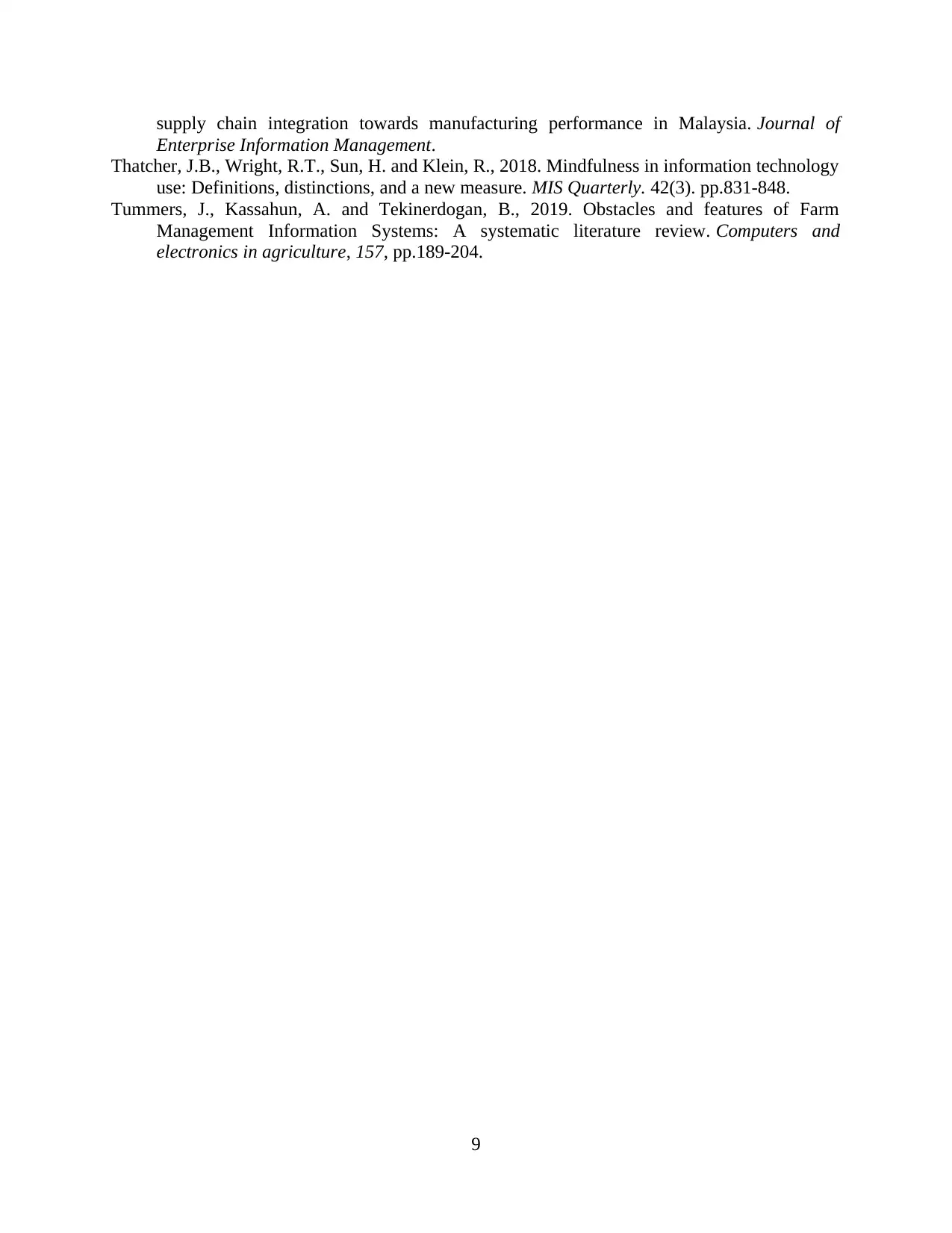
supply chain integration towards manufacturing performance in Malaysia. Journal of
Enterprise Information Management.
Thatcher, J.B., Wright, R.T., Sun, H. and Klein, R., 2018. Mindfulness in information technology
use: Definitions, distinctions, and a new measure. MIS Quarterly. 42(3). pp.831-848.
Tummers, J., Kassahun, A. and Tekinerdogan, B., 2019. Obstacles and features of Farm
Management Information Systems: A systematic literature review. Computers and
electronics in agriculture, 157, pp.189-204.
9
Enterprise Information Management.
Thatcher, J.B., Wright, R.T., Sun, H. and Klein, R., 2018. Mindfulness in information technology
use: Definitions, distinctions, and a new measure. MIS Quarterly. 42(3). pp.831-848.
Tummers, J., Kassahun, A. and Tekinerdogan, B., 2019. Obstacles and features of Farm
Management Information Systems: A systematic literature review. Computers and
electronics in agriculture, 157, pp.189-204.
9
⊘ This is a preview!⊘
Do you want full access?
Subscribe today to unlock all pages.

Trusted by 1+ million students worldwide
1 out of 12
Related Documents
Your All-in-One AI-Powered Toolkit for Academic Success.
+13062052269
info@desklib.com
Available 24*7 on WhatsApp / Email
![[object Object]](/_next/static/media/star-bottom.7253800d.svg)
Unlock your academic potential
Copyright © 2020–2025 A2Z Services. All Rights Reserved. Developed and managed by ZUCOL.





